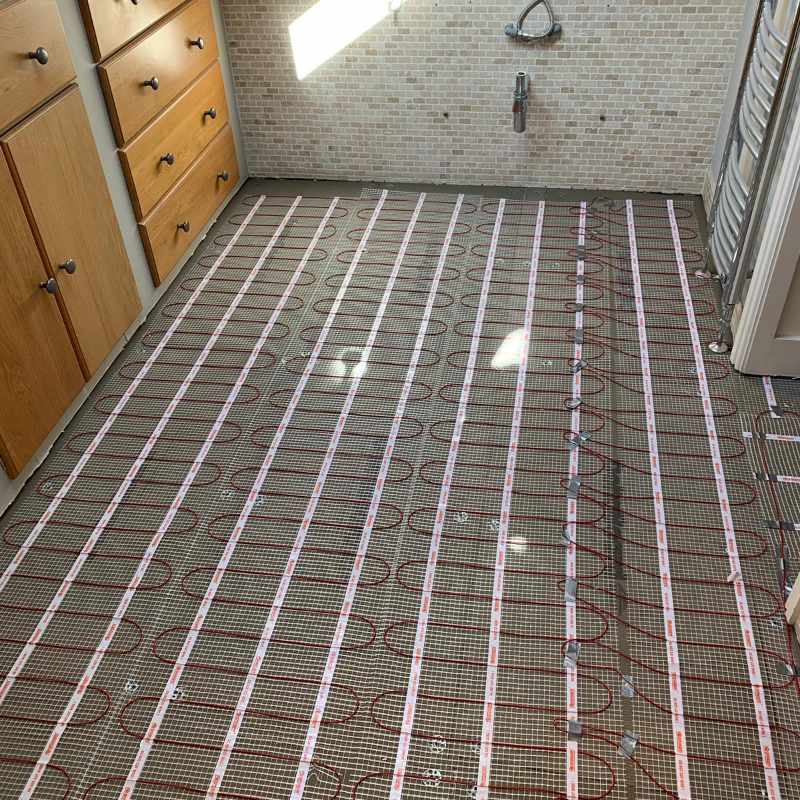Can You Fix Underfloor Heating?
Underfloor heating is more energy efficient than radiators and looks sleeker in either a home or business. It gives an even heat and different areas can be separately controlled.
But, can underfloor heating be repaired?
Yes, it can, and without removing your whole floor.
What is underfloor heating?
Underfloor heating involves laying pipes or electrical cables under your flooring to circulate heat instead of using radiators.
While it can be expensive to install and can be inconvenient having to lay a new floor, it can be between 15-40% more energy efficient than radiators. This can help reduce your energy bills while keeping you nice and warm.
Types of Underfloor Heating
There are two types of underfloor heating: water (wet) and electric (dry).
Water underfloor heating (wet)
Using a wet system means pipes are laid underneath your flooring to circulate water through to heat your home. The pipes are clipped and covered with screed.
Wet underfloor heating is best for solid floors and ground floors. Water is cheap to run and can be used in large areas or for multiple rooms.
Electric underfloor heating (dry)
An electric underfloor system uses electrical cables which are clipped between joists on insulation. It is best for floating floors, wooden floors, or upper floors. It is easier to install on existing floors with minimum disruption.
Underfloor heating can be used on different types of flooring from wooden floors to laminate, carpet, and tiles. A qualified engineer can advise on the best one for you.
How does underfloor heating work?
The wet system requires a heat source and a pump to send the water through the pipes under your floor. The heat source can be a boiler or renewable heat pumps. A thermostat controls the temperature in each room.
A dry underfloor heating system uses electrical cables or electric mats which can be rolled out. These cables are good for rooms with awkward layouts.

The benefits of underfloor heating
- You can design your room the way you want because there’s no radiators taking up space. This gives you more options to arrange furniture and looks sleek and modern.
- Underfloor heating is low maintenance. You don’t have to do anything especially with programmable thermostats and automatic Smart WiFi thermostats.
- Underfloor heating can be used in all rooms, not just bathrooms or kitchens.
- There is an evenly distributed heat. Radiators send out hot air, which rises and cools, making your ceiling warmer than you might be on the sofa.
- It’s energy efficient. When combined with a condensing boiler, underfloor heating, can achieve over 90% energy efficiency.
- It can save you money. As it is more energy efficient and the temperature is lower than radiators, it can reduce your energy bills. You can also control the heat easily in different areas of your home or business to lower or turn off the heat in less-used areas.
- There is better air quality with underfloor heating. There is more oxygen in the room than with radiators and it can be better at removing pollutants. Floor heating increased the pollutant removal effectiveness by 5% in a study, and reduced personal exposure by an average of 22%.
Points to consider with underfloor heating
Underfloor heating is generally a reliable source of heating.
Some possible disadvantages of underfloor heating are:
- It can take 30 mins to an hour to heat up.
- Electric underfloor heating is usually faster, but water gives constant heat.
Can underfloor heating be repaired?
Yes, it can. Engineers can pinpoint faults under a floor within millimetres, so they can take up the section not the whole floor.
How can you tell if there is an issue with underfloor heating?
Some issues you may experience, although unlikely, are:
- Trapped air
- Losing pressure
- Overheating
- Patchy heat
- Cold spots
- Leaks.
These issues can all be easily fixed if any of them should be a problem.
The system may have trapped air, just like radiators. You may hear noises from your system if this is the case. Underfloor heating is a silent system, so any unusual noises should be easy to identify.
The solution is to bleed the system, as you would your radiators, by opening the valves to release air.
If you are losing pressure, there may be a leak. Check your pipes are connected to the manifold (system that controls the flow of water) are not leaking, however, it is rare for underfloor heating pipes to leak.
If your floor is not heating up or has cold spots, it could be an issue with the valve actuator resulting from a sticky pin valve underneath the actuator. If the actuator has failed completely, it will be an electric issue with the thermostat or wiring board.
The most likely issue to occur with your underfloor heating would be something happening during installation. Which is why it is important you use qualified underfloor heating specialists to install your underfloor heating. There are also warranties with qualified engineers that can give you peace of mind.
Using professional engineers for your domestic or commercial heating system, such as Add Heat, means the whole process is managed. We oversee your design, supply, installation, and maintenance.
Make sure when choosing an engineer that they are Gas Safe Registered, OFTEC Registered, and have experience installing underfloor heating.
How to maintain your underfloor heating
Whether a dry or wet system is used, they are both maintenance-free.
You should ensure your boiler is serviced yearly as this is more likely to have problems than your underfloor heating.
You should also insulate external pipes to protect than from bad weather, so they don’t freeze.
If you would like any more information about underfloor heating, please do not hesitate to contact us.